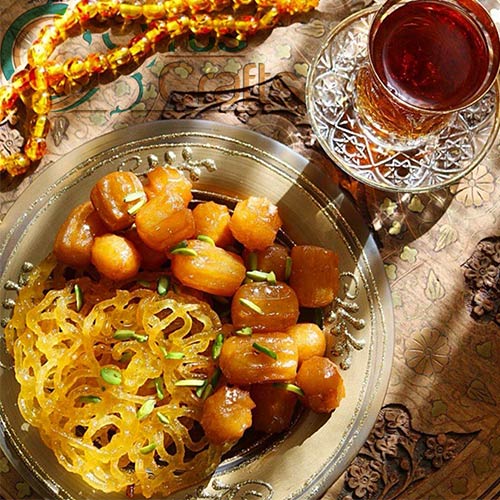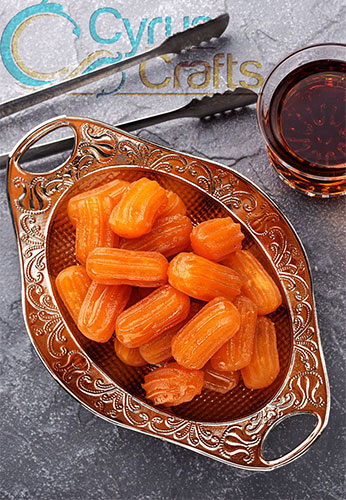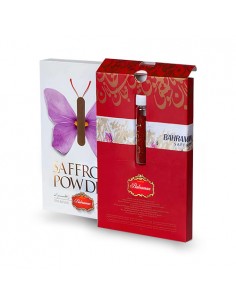- Y.SH
- information
- 2144 views
- 0 comments
Bamieh is a famous type of Iranian sweet that becomes super popular during the month of Ramadhan. During that month, this Persian sweet with saffron and rosewater can always be found on the Iranian dining table at Iftar. Another type of Iranian sweet is called "Zoolbia." These two types of sweets are usually served together; they are delightful to eat.

About Bamieh
In Persian cuisine, it's called Bamieh or Bamya in Arabic. Turkish cuisine it's called Tulumba. In Arabic cuisine, Datli/Balah Alsham or Bamya, and in Spanish/Mexican cuisine, it's called Churros.
The difference is that the Middle East is dipped in sugar syrup after deep frying and garnished with pistachios. In Turkey, they use lemon-flavored syrup. Lebanon and Syria often use orange blossom instead of rose water for flavoring, and in Morocco, they use heated honey instead of syrup. Mexican/Spanish Churros are coated with sugar and cinnamon powder or served with chocolate dip.
Alternatively, Iranians add cardamom and saffron to banish syrup and rose water.
These yummy deep-fried crisp-shelled treats deliver a serious kick of saffron and sugar as they are soaked in thick, saffron-flavored syrup, and they are a quintessential part of the holy month of Ramadan.
Cyrus Crafts; Luxury & Unique Products
What Is the Difference Between Zoolbia and Bamieh?
Fried desserts from the Middle East, Zoolibia and Bamieh, are coated in rose water and saffron syrup, but they have different shapes and are made with different types of dough. Like churros with a donut texture, Bamieh is made with choux pastry-like dough and shaped with star-tip piping bags. Zoolbia is made with a thin batter and shaped using a squeeze bottle, similar to funnel cakes with a crispier texture.
The difference between Bamieh and churro
Bamieh is similar to churros, but it looks more beautiful and eye-catching. But Churros taste very similar to a cinnamon-sugared doughnut. The dough of the churro, just like bamieh is passed through a piping bag with a star-shaped nozzle attachment; this creates long crispy ridges in the pastry as it fries; these ridges help hold the cinnamon sugar in place.

Bamieh Recipe
The perfect end to any meal, these addictive sweets will keep you coming back for more. When they are drenched in syrup, they melt in your mouth! Now it's time to make Bamieh.
The Syrup
- A small saucepan should be filled with sugar, glucose, lemon juice, and 1/2 cup water over medium heat. Bring the mixture to a boil and stir until the sugar dissolves. Simmer for 5-7 minutes. (Bamiehs will have a shiny finish if liquid glucose/corn syrup is added to them.)
- Cook for another minute with the saffron and rose water. Turn off the heat and set it aside to cool.
The Batter
This step is much like making pastry:
- To make a basic white sauce, melt butter in a medium saucepan and then bring it to the boiling point.
- To ensure no lumps in your dough, add all the flour and sugar at once. Then mix vigorously with a spatula until there is no more loose flour. Cook on low heat so enough moisture evaporates from the dough—it should be sticky but not wet to the touch. (Make sure sugar has adequately dissolved and there are no flour clumps.)
- Remove the dough from heat and flatten it around the sides of a second bowl (to increase surface area and hasten to cool).
- If the dough is too hot, it will cook the eggs and give your a sweet and eggy taste. The egg won't be incorporated well if it is too cold.
- It's better to break the egg in a bowl and whisk it before adding it to the dough. (It's best to measure ingredients by weight since volume measurements can vary depending on factors like how much air is trapped under or above an element when you scoop).
- If you are doubling the recipe, when it gets to the eggs, you should add them one at a time, making sure to incorporate each egg before adding the next one.
- Add and stir the egg vigorously with a spatula. The dough will look broken at first; don't worry and continue to beat until it's well incorporated and you get the right pipeable consistency.
- Fit a pastry bag with a star tip and spoon the dough into the prepared pastry bag.
- The shape of the pastry tip you use for Bamieh is very important. If the information isn't closed or rounded off, the Bamiyeh may break as you fry them.
- Pour oil into a saucepan to come halfway up the sides—heat on medium.
- Holding the bag at an angle so the tip is a few inches above the surface of the oil, squeeze out the dough, then cut it off at the tip to release it into the frying pan.
- To cut single pastries, use a pair of scissors, a knife, a spoon, or even your fingers — remember that Bamieh should be small, each no more than 2-3 centimeters long.
- Fry Bamieh, turning them over until golden brown on all sides. Transfer to a paper towel-lined baking sheet.
- Soak the hot fried Bamieh in the sugar syrup for 2-3 minutes. (Ensure that the sugar syrup is cool.)
- Remove from syrup and place on a tray lined with kitchen paper.
- Now you can pour pistachios or coconut powder on the Bamieh.

Place the Bamieh in beautiful dishes such as Minakari plates, garnishing with ground pistachio, and dried rose petals. You can serve it hot, warm, or at room temperature with a cup of Persian tea. Also, remember, like all other fried sweets, they are best when eaten on the same day.















Comments (0)